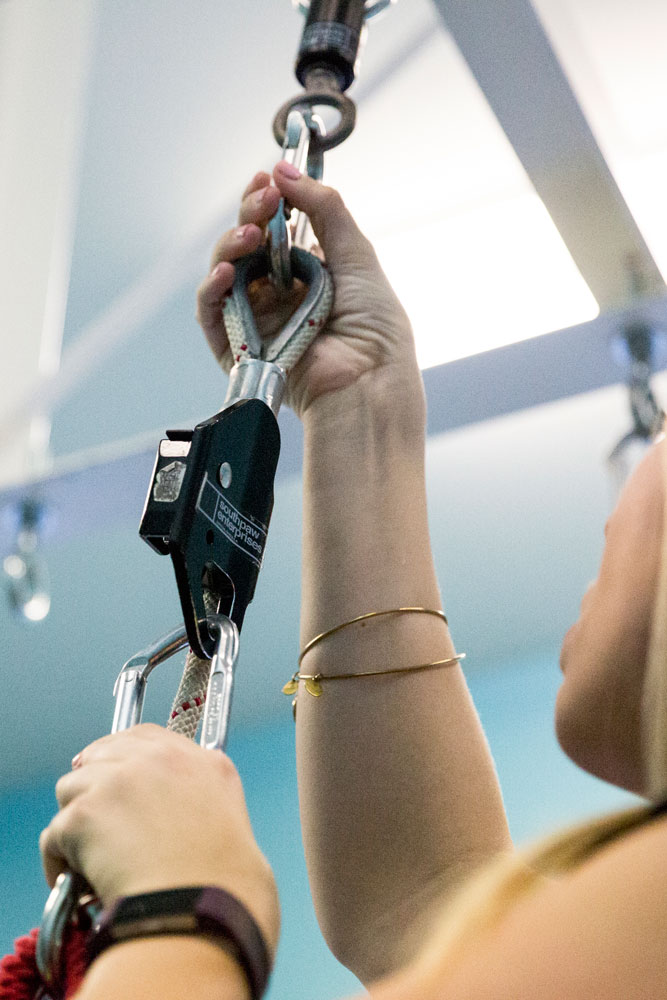Adult Resources

Sensory Processing Disorder in Adults
Adults have historically been overlooked when it comes to sensory processing disorder. Often, adults have received other diagnoses which did fit the symptoms. Treatment for these diagnoses often helped, but may have been short lived or there seemed to still be something missing from understanding themselves and from the overall treatment. What may be missing is a sensory approach.
What is different about sensory integration from other treatment approaches is that it is a “bottom up” approach. This means that treatment is geared toward using the body to provide sensory input that is helpful for the unconscious brain to feel more relaxed, more focused, and to move and perform day to day activities feeling better coordinated and with less stress. It frees up mental capacities for cognitive approaches, such as counseling, to be more effective.
Adults often report feeling more confident and empowered. The first step is identifying their sensory patterns through evaluation. Treatment involves organizing the nervous system and gaining greater awareness through sensory-based activities. Once they are able to understand their own sensory patterns, they can better recognize triggers, make daily decisions that work more successfully, and proactively arrange daily routines for better functioning and greater joy.
Sensory Systems
The vestibular system is very important. It provides the brain with information regarding the pull of gravity on a constant basis which gives us a sense of our orientation. It is like the star on the map saying, “You are here.” Gravity processing is the basis for our muscle tone and strength particularly with the muscles along our spine giving us a sense of where our center is.
The vestibular system also lets your brain know whether you are moving or still and the position of your head. In this way, it is very important for balance, controlled/skilled movement, and the ability to stay still. It alerts the muscles to know how to respond to keep from falling down.
The vestibular system gives the brain information about the head position in all possible directions. It also works closely with the eyes to stabilize the field of vision. The vestibular system is also connected with the neck muscles to turn the head for greater visual range and for the eyes and ears to orient to and locate sounds. In this way, the vestibular system is very important for spatial orientation.
Proprioception is the joint and muscle position sense. It is highly integrated with the sense of touch in order to grade the amount of force or pressure to exert when handling or coming in contact with the environment. An example would be how to hug without squeezing too tight or so loosely that it seems insincere. Being able to position tools in the hand and coordinate all the movement of all the joints for successful manipulation would be another example.
Proprioceptive and vestibular integration is foundational for muscle tone and the ability to move automatically and responsively to the environment and task. For example, being able to walk through a room adjusting movement and posture to avoid walking into things and to position the body accurately to sit in the chair and not fall out.
Proprioception is also very regulating. Have you ever been feeling stressed out and then you exercise and feel better afterward? Using the muscles helps to relieve tension and stress giving us a better sense of calm. Moving and using our muscles can also help with focus and attention by waking up when we feel sleepy.
Most of us are familiar with touch. We can pretty well identify things that feel good on our skin. But, touch gives us a ton of information about the world around us when we are not even thinking about it. We are always in contact with some surface giving us connection and grounding information that helps refine our balance. Many of our touch receptors involve vibration which also allow us to work with our muscles/proprioceptors to grasp and maneuver and catch objects that move along our skin. Temperature receptors are a type of touch and keep us safe in a variety of ways. It is through our skin that we come into contact with the world. Our sense of touch works with all the other sensory systems to navigate our body through the world, coordinate how we use our body as a tool, and to utilize physical tools for daily activities. Something that is hard to feel is hard to manipulate so we end up feeling clumsy and probably avoid tasks that require precise use of our hands.
Touch also influences our relationships and social connectedness. Touch is very important from birth in connecting and forming healthy attachments to our caregivers. When the nervous system interprets touch as harmful, it can feel painful making relationships and the ability to self-regulate strained.
Touch is also important for spatial processing. As we manipulate things by holding them in our hands or placing them in our mouths, we get a sense of depth, texture, and dimension. Touch, then working with our other body senses, contributes to the space and objects around us. When touch does not work well in this sense, there may be difficulty judging space and often impulsive movement or bump into the things frequently. There may also be a need to touch things that our eyes see.
Hearing involves more than just detecting sounds. Listening involves the whole body including the other senses. The brain combines what it hears, where the sound comes from, and information from the other senses to make meaning from sounds. Much of our ability to make sense of the world and to communicate with others involve the ability to process sound.
On an unconscious level, the brain filters out background noise and focuses on foreground sounds. Sound informs our brain about happenings outside of us. With information from the other sensory systems it is able to make sense of what it hears. This is what helps us to have conversations while mostly tuning out what is happening around us. It helps us to focus.
Sound is happening and being processed constantly. Sounds can occur quickly and without warning. It can be pleasant or jarring. It can be a soft whisper or overwhelming roar. It can be organized into beautiful music or be random, chaotic noise. Sound is much more difficult to process when our body senses, vestibular, proprioception, and tactile systems are not well integrated.
Sight is the last sense to develop and for most, becomes our dominant way of interacting with the world. When we are born, we have little and very vague visual information. This seems to allow for the body senses of touch, proprioception, and vestibular to more fully mature before our eyes take over. The body senses enhance how our brain is able to perceive or make sense of and interpret more accurately what it is seeing.
Vision needs to integrate well with the vestibular system and the proprioceptors of the neck to stabilize the field of vision. It is like using a tripod to stabilize a camera so that what your video is easy to watch. This has a lot to do with the ability to pay attention, focus, and read. We call this ability to coordinate the eye muscles and use them independently of the head oculomotor control. A stable visual field and good oculomotor control are foundational for the ability to use our eyes and hands together. We call this visual motor integration.
The sensory receptors for taste and smell are called chemoreceptors. This means that they detect molecules that are in the air for smell and molecules that are a part of substances for taste. Taste and smell are very interrelated and highly subjective. Have you ever noticed how if you can’t smell something, it has a lot less taste?
We may think that eating or exploring with the mouth is all about taste. That is true, but especially with exploration it is to a large extent about texture. The lips and mouth are densely populated with touch receptors. This can be why we sometimes place things on our lips or cheeks to feel them more intensely.
When our sense of touch in the mouth is under responsive like after being numbed from a dental visit, it can be very difficult to chew and swallow food successfully. Articulation, or pronouncing sounds clearly when speaking, can also be difficult. The tongue, jaws, and lips are highly dynamic muscles to coordinate and rely heavily upon the sense of touch in the mouth.
When children have difficulty with feeding or are highly selective of foods it is often a combination of tolerating texture and coordinating all the muscles for manipulating food in the mouth. One of our first survival instincts is to breathe. When food can potentially make us choke, we will avoid eating it and it is actually much safer to not eat it until it can be successfully chewed and swallowed. When there is difficulty feeling food in the mouth and/or coordinating the muscles for eating, the food selection will be limited and new, potentially dangerous foods (as in they may cause choking) will be avoided.
The jaw muscles are the most powerful proprioceptors for their size in the whole body. For this reason, chewing on objects and clothing often occur when seeking proprioception, a need to feel more stable what we call postural control or joint stability, and/or when the eye muscles need more stability to focus as a team. Sucking or chewing can also be very regulating. As you can see, there are a number of reasons these behaviors may occur and the key is to identify what need is being met with the behavior.
Interoception is the sensation of functions within the body such as digestion of food, feeling full or hungry, the need to go to the bathroom, breath in the lungs, etc. Not being able to identify what is going on inside oneself may also be called alexithymia.
One of the great days of celebration in parenthood is when children become “potty trained.” Up until that day, infants and toddlers are developing overall body awareness through exploration and movement. It is not until later that the more refined sense of interoception is able to be perceived, interpreted, and acted upon. Difficulty with interoception often contributes to difficulty with eating, pottying, staying dry through the night, and accidents.
When we start to understand all the things our senses do for us, then we can discover how they are helping or hindering us. This is just what we will do during our meeting together. We will discover your or your child’s sensory patterns to give us new insight and understanding to how it is helping or hindering daily living.
So please come with questions and whatever details you believe will be helpful. Some parents bring samples of classwork, videos, or other reports. These are all providing insight in a different way. We look forward to meeting you soon!
”I’m a grad student in my mid-twenties who worked with Elise for a year. I have lived my entire life with sensory integration problems. My parents (and I) knew there was an issue, but didn’t know what the issue was, if that makes sense. It didn’t help that I tried to hide the symptoms from my parents out of a fear of acknowledging that I was experiencing different things internally than most people. And the symptoms, to put it bluntly, suck. Essentially, everyday stimuli prompt a flight or fight reaction. Of course, this always happened in places where neither flight nor fight was ever and option, so I would just sit and suffer in silence and lose all other cognitive ability that to contain the reaction. As long as the stimuli was there (for me it was certain types of noises, especially chewing) the stress was not just present, but it would escalate. Your family members or friends can cause you pain without ever realizing they’re doing so. Then the stress of it leaves you tired mentally and emotionally, but physically tight, defensive, and on edge. It’s a joy-sucking way of living.
Eventually I broke down and confided the extent of what was happening with my family when I was in my late teens. It took another five or six years to finally put a label on it, and even longer to find someone like Elise who could specialize in treating it. Working with Elise has been wonderful. The best way I can describe the effect is that much of the pressure, the daily stress that’s accumulated over the past twenty-plus years, is lifting. The response to negative stimuli hasn’t gone away, but my tolerance of it is better. I count myself extremely lucky that I found Elise, for she’s been kind, patient, knowledgeable and helped me far more than I thought possible. It’s not like previously the disorder had shown any sign of abating over time, and I can say with 100% certainty that because of Elise I’m in a better place in my life.
Adult Patient



